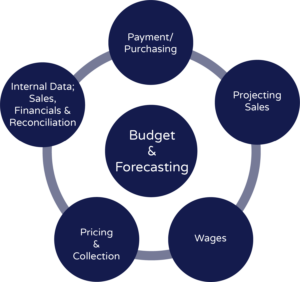Budgeting: A Financial Road Map to making Smarter Business Decisions
Understanding and pro-actively managing your business finances is more important now than ever. Two of the best practices positively influencing your situation and focusing on what you can control instead of can’t control are:
- A Game plan: A set of goals and strategic priorities to deliberately focus on, move towards every day, and give you something positive to invest your energy into.
- A Budget and set of financial projections/forecasts: To manage, compare to, and to make better business decisions to improve the situation by having the information of knowing how to adjust your sales and know what to aim for.
Having a Game plan and budget to complement each other, allows your plan to be backed up by numbers. Giving you tools to put yourself in the best position possible and capitalize on opportunity when things turn around.
In this first of a two-part series you will find important principles and practices regarding budgeting and forecasting. In part two we will talk about integrating goal setting and strategic planning into the budgeting process so they both support each other and can be tools to support the sustainability of the business.
The Power and Purpose of a Budget
A well-planned budget and financial forecast provide a road map to support you in making S.M.A.R.T.E.R. business decisions. Using this handy acronym, we can remember some important budgeting principles.
- Specific – I.E. 300,000 in sales, 500 customers, 6,000 transactions, or Avg transaction of $50 are needed to hit our sales and or profit goals.
- Measurable – Is it measurable? How is it measured?
- Action oriented – It is focused on what you can do? What you can control?
- Results orientated – Is it focused on results or activity? The activity needs to lead to a result!
- Timely – By when? For what period?
- Evaluate – the options, circumstances, strengths, challenges, threats, opportunities
- Re-evaluate – Reflect, adjust, correct, repeat.
Knowing you need $300,000 per year in sales to break-even helps give you a specific target to hit. Then by knowing your road map to hit those sales numbers, in terms of activity, transactions, volume of customers, and average transaction size empowers you to know what numbers you need to hit to turn your plan into results.
With businesses adjusting to the impacts on their financial business model, budgeting is even more important now, then ever. The process helps us understand how to support our current and new realities based on adjustments to what sales are: currently, where they will be, when will they stabilize, and the staffing and expenses it takes to support those sales and to deliver what you do with quality and profitability. Simply put, what business looks like under these new conditions and in the future, how do we adapt, and what is a sustainable and profitable business model? The budgeting process helps us access our options.
3 Phases to the Budgeting and Forecasting
- Evaluation – make sense of past performance and identifying how those factors, current and future, may influence cashflow.
- Planning – utilize the information complied during the evaluation phase to forecast a budget and make assumptions of how certain variables will be impacted.
- Manage & Navigate the Territory – apply the budget during the planning phase and monitor monthly performance and key performance indicators. Manage the day to day, to help you stay on track throughout the month, so at the end of the month you arrive at what you aimed for!
Budgeting gives us the ability to review all the details of our business, big and small; giving us a global and detailed perspective to determine our options, best courses of action and day to day management decisions.
Management & Budgeting
Owners of the business should use their budget as a means of management control. They should compare actual results to the budget amounts on a monthly basis. Reviewing key performance numbers helps determine what changes or adjustments need to be made to achieve the goals laid out. This will help sustain and maximize financial performance. Pro-actively looking at cashflow can prevent problems and allow you to find or capitalize on opportunities that may present themselves weather in plain sight or hidden underneath the details.
Types of Budgets: A Profit Budget and Cash Flow Budget
Two types of budgets you can use as a means of management control are a cash flow budget and a profit and loss budget. Most business owners do not know that there is a difference between their profit position and cash position. It is one of the most misunderstood business concepts.
- A profit and loss budget concentrates on income and expenses to be incurred in the business during a specified period. What is your sales forecast, how and what will you spend on expenses, and what is your projected profit or loss?
- A cash flow budget includes everything in your profit and loss budget plus other sources of cash inflows including loans and any cash the owner will invest back into the business. It projects all cash outlays including loan repayments and owner’s withdrawals of cash.
Budgeting and Forecasting: You need both!
Creating a budget is done at the beginning of the year. Forecasting is what takes places once you implement a budget, and when tracking your progress. You are looking at your numbers throughout the year and estimating (forecast and re-forecasting) where they will be in the upcoming months, based on where you are at now, and compared to where you were in the prior period. Just like the weatherman has an updated weather forecast every day or week, so does your business each month and quarter. Each forecast serving as a reset point based on your new current position. This allows you to continuously evaluate and revaluate your current landscape and assumptions for the best way to move forward.
Knowing your Numbers is more important NOW then ever!
 Developing and Implementing a budget can seem intimidating but the process can be made simpler. You can use an excel spreadsheet to budget and forecast , especially once you have your reports and templates properly set up and streamlined.
Developing and Implementing a budget can seem intimidating but the process can be made simpler. You can use an excel spreadsheet to budget and forecast , especially once you have your reports and templates properly set up and streamlined.
We cannot control everything, but having a budget and game plan in place, empowers us to influence what we can control. This will force us to look at our businesses differently and how we do business, in terms of both the financial model of the business, and the goals we need to be focused on.
Owners that do not understand their numbers, are more likely to have their numbers control them. Owners that understand their numbers, what they have been, and where they might be, and having evaluated different scenarios, will be in a better position to influence their own destiny.
For more information on budgeting, forecasting, developing a strategic plan, or on how these tools can empower you in making smarter business decisions, register for a workshop: Live Events or call (414) 269-8705.
Recommended class to learn more:
Essentials: Business & Growth Essentials
Mastery: Budgeting and Sales Forecasting, Strategic Planning



